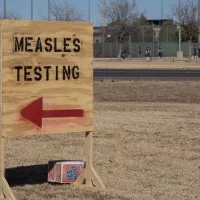
PeopleImages/iStockBy LAURA ROMERO, ABC News
(NEW YORK) — In recent months Sharp Chula Vista Medical Center in San Diego’s South Bay has been near capacity with coronavirus cases. Located 11 miles from the Mexican border and serving a primarily Latino population, the hospital has seen an ongoing high number of infected patients.
But now doctors and nurses in the 343-bed hospital said they are preparing for even worse this fall, when the upcoming flu season amid the coronavirus pandemic poses a looming double threat that could severely strain the health system.
“Flu season can hit really hard,” said Leslie Gomez, a nurse in the Emergency Department at Sharp Chula Vista. “And COVID-19 has been devastating so I’m worried that these two forces will combine and cause a really difficult fall and winter.”
The flu is significantly less deadly than the coronavirus, according to the Centers for Disease Control and Prevention, but it is so widespread that the CDC says that influenza has resulted in between nine million and 45 million illnesses, between 140,000 and 810,000 hospitalizations and between 12,000 and 61,000 deaths annually since 2010 in the U.S. Meanwhile, more than 32,500 of Americans are currently hospitalized with the coronavirus, the COVID Tracking Project says, and more than 190,000 have died, according to a count by Johns Hopkins University.
The looming threat of potentially hundreds of thousands of additional hospitalizations has sent some medical facilities already hard-hit by COVID-19, like Sharp Chula Vista, scrambling to get ready in time.
“We are on our way to being prepared,” said Gomez. “We’re all a little nervous, but I think we got it. I think we can do it.”
One particular fear, according to Los Angeles Health Services advisor Dr. Atul Nakhasi, is that since both COVID-19 patients and flu patients who are admitted to the hospital can need breathing tubes and ventilators, hospitals may face a strain on medical supplies.
“I’m a frontline doctor who works over flu season and I can tell you that many times during flu season, ICU beds are taken, hospital beds are taken, ventilators are taken. We need to be prepared for a level of stress on the health system we have not seen,” said Nakhasi, who is a primary care physician and policy adviser at the Los Angeles organization, the nation’s second-largest health system.
In 2018 Alabama saw a flu season so bad that the local government declared a state of emergency. Dr. Bernard Camins, professor of Medicine at the Icahn School of Medicine at Mount Sinai and the medical director for Infection Prevention for the Mount Sinai Health System, was a front-line worker at the time at the University of Alabama Hospital.
“That year, we had to cancel elective surgeries to make more room for flu patients,” Camins told ABC News. “We ran out of ICU beds and we couldn’t have surgeries because there weren’t any recovery rooms, the emergency room was very crowded. Now with COVID, hospitals might have to cancel surgeries again if there is a second wave because of flu season.”
Gomez said that to get ready, Sharp Chula Vista is looking into setting up disaster tents in the parking lot that have been used during hard-hit flu seasons in the past and expanding the emergency room to allow for separation between patients. More staff has also been hired to increase the number of screeners at entrances to catch anyone with high temperatures or other symptoms.
Dr. Hai Shao, the medical director of Infection Control and Hospital Epidemiology at Sharp Chula Vista and chair of the System Hospital Infection Prevention Committee for Sharp HealthCare, said he anticipates there will be greater pressure regarding how the hospital uses its medical supplies and protective equipment.
To rapidly make a diagnosis and manage the flow of the emergency room, Shao told ABC News that Sharp Healthcare is hoping to introduce an on-site molecular testing device for a rapid diagnosis of both influenza and COVID-19 this fall, rather than just testing for COVID-19 as most tests currently do. The testing device, awaiting FDA approval, would conduct 15 tests per hour and would take about 20 minutes to provide a result.
The testing device, developed by Swiss pharmaceutical company Roche, is meant to allow healthcare providers to tell the difference between patients showing similar sets of respiratory symptoms from a single sample.
“These are the new tools and weapons that we did not have last year,” said Dr. Shao. “If there’s a large volume of patients rushing into our ER, we will be able to tell if a patient has the flu or COVID-19 in 20 minutes. This is going to help out ER physicians tremendously.”
A spokesperson at Loma Linda University Health in California said it was planning to continue using triage tents in the parking lot and reimplement visitor restrictions to limit the number of people in the medical center.
“We’re actually going to be maintaining the more rigorous visitor restrictions as we go into flu season and continue to battle COVID,” said the spokesperson, Briana Pastorino.
SSM Health in Missouri is hiring more staff for its eight hospitals across the state and purchasing protective equipment to prepare for flu season.
“We don’t know what is going to be the additional burden of COVID,” said Dr. Garza, SSM Health’s chief community health officer and incident commander for the St. Louis Metropolitan Pandemic Task Force. “We are ramping up on staff and supplies so we can be prepared.”
But the best way to avoid overcrowding in hospitals, Nakhasi said, is to ensure as many people as possible get their flu shots this year. The CDC has worked with vaccine manufacturers to have extra flu vaccines available this season and recommends getting the vaccine before the end of October.
“That is the most critical thing because if we can reduce the flu number down to a manageable number, that gives hospitals a fighting chance to battle COVID this fall and winter,” Nakhasi said.
Copyright © 2020, ABC Audio. All rights reserved.















